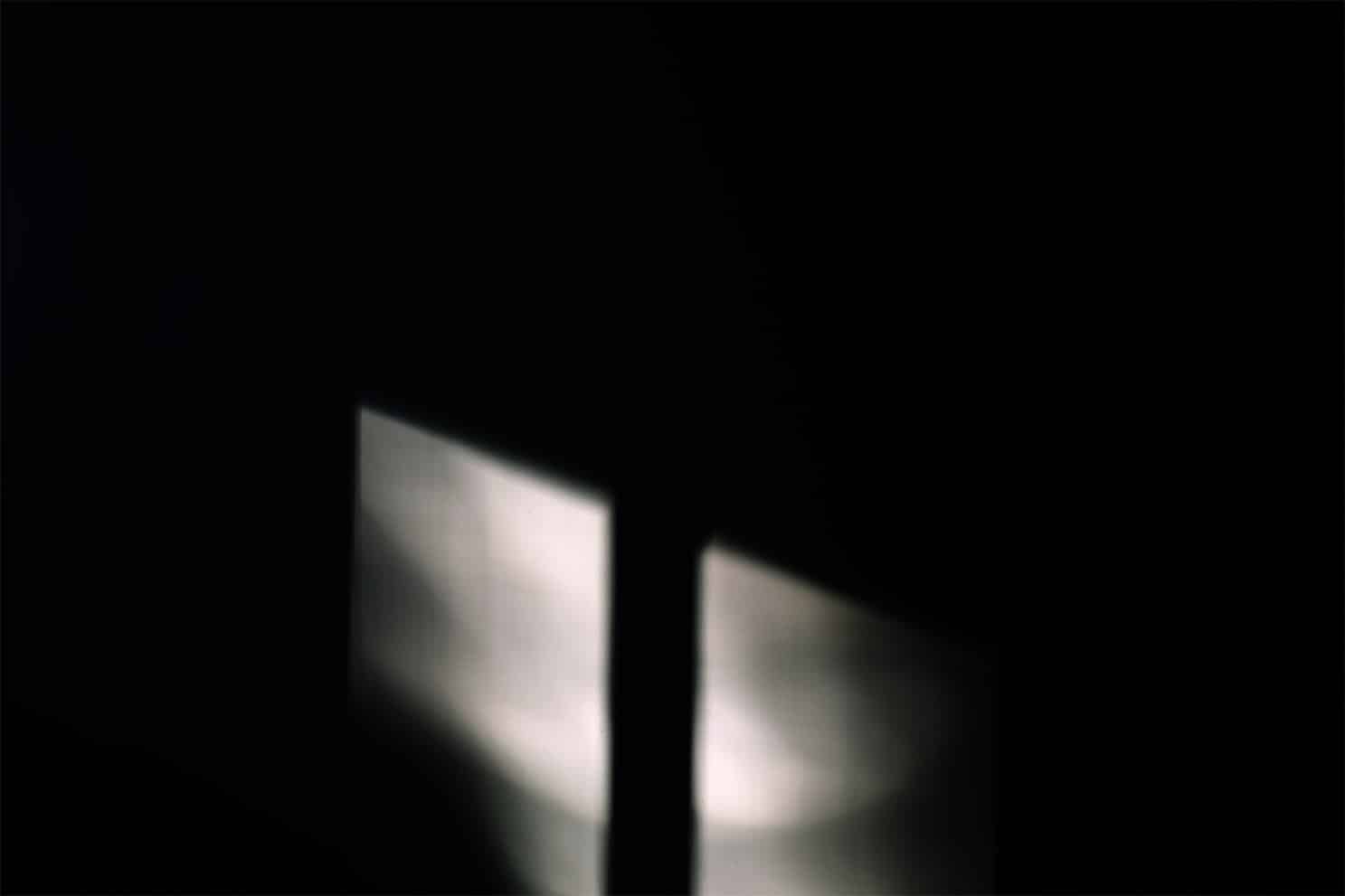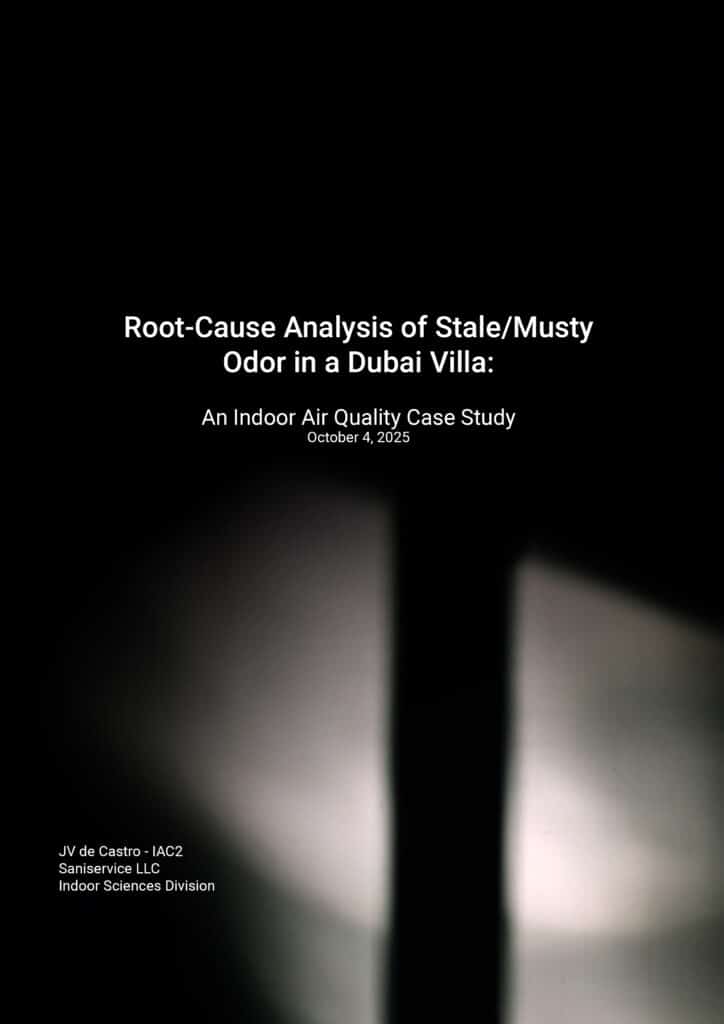
What Our Stale & Musty Odor Case Study Revealed — And Why It Matters as Winter Approaches in the UAE
A Subtle Smell, A Serious Signal
When our Indoor Sciences Division was called to investigate a persistent stale, musty odor in a Dubai villa earlier this year, it seemed at first like a common comfort complaint. The client simply wanted to “get rid of the smell.” But as our team knows all too well, odor is rarely just an olfactory nuisance. It’s a symptom of deeper environmental imbalance — a potential warning sign of hidden moisture, microbial growth, or ventilation failure.
Our recently completed Stale, Musty Odor Case Study in Umm Suqeim, Dubai, offers one of the most detailed technical pictures yet of how negative air pressure, inadequate ventilation, and moisture dynamics interact to degrade indoor air quality (IAQ) in UAE villas.
What we discovered over five days of intensive investigation underscores a larger truth: that persistent odors are diagnostic, not cosmetic. And as the UAE moves into the cooler months — when homes stay sealed tighter and air systems operate at lower load — the relevance of these findings becomes even more urgent.
Why We Conducted the Study
Odor complaints are among the most frequent IAQ concerns we receive in Dubai. They often surface after periods of humidity, low airflow, or prolonged closure — conditions that are all typical during the transition into winter.
This particular case involved a multi-story villa in Umm Suqeim where occupants noticed a recurring musty odor, strongest in the evenings and early mornings. The house appeared clean and dry, but the odor persisted despite surface cleaning, fragrance treatments, and even AC servicing.
That’s when the homeowners contacted us for a full root-cause analysis — not just deodorization. Our goal was to determine scientifically:
- What was causing the odor?
2. What systems were involved?
3. How could it be permanently resolved?
Our Method: A Multi-Layered Investigation
We approached this case with a comprehensive IAQ and building physics framework — combining continuous monitoring, microbiological testing, and HVAC diagnostics.
Over five days, we deployed calibrated sensors and sampling tools across multiple zones of the villa to measure:
- Temperature, humidity, CO₂, TVOCs, formaldehyde, and PM2.5 — logged hourly.
- Airborne and surface microbes — measured as CFU/m³ (air) and CFU/cm² (surface).
- Building pressure — to detect airflow direction and infiltration.
- HVAC system integrity — including fresh air supply, return ducts, drain pans, and coil hygiene.
- Plumbing and structure checks — to rule out moisture migration from leaks or traps.
The data was then analyzed through correlation matrices and regression modeling — the same methods used in published UAE IAQ research — to reveal cause-and-effect relationships between physical, chemical, and biological indicatorsStale Musty.
Download the Case Study
What We Found Inside the Villa
1. The Building Was Constantly “Sucking In” Air
Every room measured negative air pressure — averaging around –7 Pascals (as shown in Figure 4 of our report). In simple terms, this meant the villa was inhaling air from service voids, wall cavities, and outdoor cracks rather than exhaling it through a balanced system.
This constant inward pull carried humid, stale air from unconditioned spaces into occupied zones. Negative pressure is the invisible force behind many odor complaints; it draws contaminants into the breathing zone instead of pushing them out.
The root cause was mechanical — an undersized fresh air system combined with strong exhaust without makeup air (notably from the kitchen). Without balanced airflow, every exhaust fan became a suction pump.
2. Humidity and Odor Rose and Fell Together
Over the five-day monitoring period, indoor relative humidity (RH) ranged from 45% to 85%, exceeding the WHO’s comfort limit of 60% during nearly half of the logged hoursStale Musty Odor Case Study.
Whenever humidity climbed, both TVOC and CO₂ levels spiked — revealing a clear moisture-ventilation coupling. Statistical analysis confirmed this link:
- RH vs TVOC: r = 0.72 (highly significant)
- RH vs CO₂: r = 0.68 (highly significant)
These results (see Figure 1 and Figure 3 in the case study) show that odor intensity followed humidity — not temperature or occupancy. Moisture was the trigger. When the air got wetter, volatile organic compounds (VOCs) released faster from surfaces and building materials, while microbial VOCs (MVOCs) intensified from hidden damp spots.
In practical terms, that musty smell in the evening wasn’t random — it was a signal of moisture reactivation deep within materials and mold reservoirs.
3. The Microbial Footprint Told the Story
Our surface sampling revealed severe microbial contamination in localized areas. While air samples showed modest counts (typically below 100 CFU/m³), the bathroom ceiling registered over 5,600 CFU/cm², dominated by Stachybotrys and Aspergillus speciesStale Musty Odor Case Study.
Other high readings included:
- Bathroom floor: 3,140 CFU/cm² (Penicillium/Aspergillus)
- HVAC coil: 1,340 CFU/cm²
- Kitchen counter: 265 CFU/cm²
Figure 2 in our report demonstrates this contrast vividly — a 17:1 ratio between surface and airborne microbial counts.
This confirmed our suspicion: the odor wasn’t coming from the air itself, but from microbial reservoirs on surfaces — particularly in damp, intermittently cooled zones such as bathrooms and HVAC interiors.
These reservoirs release microbial VOCs, the volatile compounds responsible for that characteristic “musty” smell. And unlike traditional VOCs from paints or furnishings, MVOCs persist until their biological sources are remediated.
4. HVAC Hygiene Was a Major Contributor
Inspection of the air-conditioning system exposed several serious IAQ risks:
| Component | Condition | Severity | Action |
|---|---|---|---|
| Fresh air intake | Undersized | High | Resize and balance airflow |
| Return ducts | Missing in some zones | High | Add return ducts |
| Evaporator coils | Contaminated | Critical | Deep clean/remediate |
| Drain pans | Standing water | Critical | Repair drainage |
| Filters | Dirty | Medium | Replace |
| Kitchen exhaust | No makeup air | Critical | Install makeup air |
These findings directly explain the odor mechanism. Dirty coils and wet pans are microbial incubators. Negative pressure and missing returns allow those contaminants — along with moisture and VOCs — to circulate continuously.
Simply put, the air system had become part of the problem, not part of the solution.
5. Chemical and Biological Pollutants Were Interlinked
Our correlation analysis (page 6) showed a strong statistical relationship between humidity, VOCs, and microbial growth:
- Humidity vs Mold Growth: r = 0.89 (p < 0.001)
- Pressure vs Infiltration: r = –0.82 (p < 0.001)
These data confirm what we often observe in the field: when a villa goes negatively pressurized and humid, it doesn’t just smell musty — it becomes chemically and biologically active.
High humidity accelerates emissions from walls, wood, and adhesives. At the same time, damp surfaces become nutrient-rich biofilms releasing microbial VOCs. The result? A complex musty odor signature that standard cleaning or fragrance cannot mask.
Why This Case Study Is Timely for the UAE Winter Season
We released this report just as the UAE enters the cooler months — and not by coincidence. Our winters, while mild outdoors, are the highest-risk period for indoor stagnation.
Here’s why this case resonates now:
1. Winter Means More Time Indoors
As temperatures drop, occupants spend more time inside with windows closed and ventilation minimized. In sealed villas, this means less dilution of CO₂ and VOCs, which accumulate steadily in the air. The villa in our study exceeded CO₂ guidelines (1,000 ppm) 40% of the time — even with daily occupancy cycles. In winter, that proportion could easily double.
2. AC Dehumidification Decreases
Because cooling demand drops, HVAC systems run shorter cycles. Less runtime means less moisture removal, allowing relative humidity to rise even in air-conditioned spaces. This is precisely the condition that reactivates microbial growth and odor generation.
3. Pressure Imbalances Intensify
When indoor and outdoor temperatures are similar, natural stack pressure decreases. Mechanical exhausts (bathroom fans, kitchens) dominate, often pushing buildings into negative pressure. Without makeup air, these systems continuously draw in musty air from cavities — a situation identical to what we measured in Umm Suqeim.
4. Dormant Contamination Comes Alive
Many villas cleaned superficially during summer still harbor latent microbial colonies in coils, drain pans, and drywall. When humidity rises again, these dormant sites resume metabolic activity, releasing MVOCs detectable as that first faint “musty” smell of winter.
This is why, every year, we see a seasonal surge of odor-related service calls between November and February — the very period when fresh air systems are least active and microbial growth most opportunistic.
The Health and Comfort Implications
The UAE’s own IAQ studies, including those cited in our report (Mfarrej et al., 2020; Amoatey et al., 2018; Barakat-Haddad et al., 2024), have consistently shown that stale indoor air carries measurable health burdensStale Musty Odor Case Study. Elevated CO₂ and VOCs are linked to reduced cognitive performance, while microbial exposure can aggravate allergies, asthma, and fatigue.
In this villa, formaldehyde averaged 0.082 ppm — slightly above WHO limits — while VOCs exceeded 200 ppb for 65% of the test period. Combined with humidity and microbial VOCs, this environment presented clear respiratory and allergenic risks for occupants.
Yet the greatest risk is often behavioral: odors normalize. When people live with mustiness for weeks, they adapt and stop noticing it, even as pollutants persist. That’s why we emphasize musty odor as an early warning — a sense humans evolved precisely to detect environmental imbalance.
What We Recommended — and Why It Worked
Our engineering recommendations addressed each root cause systematically:
- Install properly sized, ducted fresh air to every habitable room.
This ensures consistent ventilation and avoids negative pressure zones. - Add return ducts where missing.
Balanced return paths prevent localized stagnation and ensure proper circulation. - Provide makeup air for the kitchen exhaust.
Eliminates suction-driven infiltration from voids and cracks. - Comprehensive HVAC remediation.
Deep cleaning of coils, drain pans, and ducts removed microbial sources and improved system hygiene. - Humidity and pressure management.
Maintain RH between 40–55%, and building pressure near +5 Pa.
After implementing these steps, the villa’s IAQ metrics normalized:
- RH stabilized below 55%
- TVOC dropped below 200 ppb
- CO₂ levels remained under 900 ppm
- Odor complaints ceased entirely
This reinforced our central finding: stale and musty odors are reliable diagnostic indicators — and they can be permanently resolved through engineering, not masking.
Broader Implications for UAE Homes and Buildings
This case is not an isolated event. It exemplifies systemic challenges across modern Gulf-region architecture:
- Over-sealed envelopes with no pressure balancing.
- HVAC systems designed for cooling, not ventilation.
- Insufficient humidity control in shoulder seasons.
- Occupant unawareness of air quality parameters.
As Dubai advances toward its Net-Zero and Smart Building goals, indoor air management must evolve accordingly. Smart sensors that monitor CO₂, VOCs, and humidity can alert occupants long before odor appears. Data-driven ventilation control — the same principle we applied manually in this case — should become standard in future designs.
Lessons Learned: Odor as a Diagnostic Tool
This investigation reaffirmed several lessons that guide our IAQ philosophy at Saniservice:
- Odor is the symptom, not the disease.
It points to moisture, microbial, or chemical imbalance. - Moisture and pressure are the master variables.
Fix those, and most IAQ issues resolve naturally. - Surface contamination drives chronic odor.
Air purifiers can’t solve a moldy ceiling or a wet drain pan. - Seasonal context matters.
What smells “fine” in summer can become problematic in winter due to lower airflow. - Data validates perception.
Numbers like –7 Pa or 85% RH translate subjective discomfort into objective action.
Our Message Ahead of Winter
As we enter the cooler season, our message to UAE homeowners, property managers, and engineers is simple:
If you smell something stale, it’s time to measure something real.
Now is the ideal time to:
- Conduct IAQ audits and pressure mapping.
- Inspect HVAC coils, filters, and drain pans.
- Verify that each exhaust system has corresponding makeup air.
- Check humidity and VOC trends using IAQ monitors.
A proactive approach in October saves months of discomfort and risk later. Odor is nature’s diagnostic alarm — the nose’s version of a smoke detector.
Conclusion: Listening to What the Air Is Telling Us
Our Stale, Musty Odor Case Study demonstrates that even modern, air-conditioned villas can silently drift out of balance — becoming negatively pressurized, humid, and microbially active without visible warning.
But the solutions are well within reach. Balanced ventilation, proper drainage, clean coils, and continuous IAQ monitoring can transform stale environments into healthy, energy-efficient homes.
As we wrote in our report’s conclusion:
“Persistent stale and musty odors must be taken seriously, serving as a call to action for robust IAQ diagnostics and engineering solutions.”
At Saniservice, we take that call seriously. Every odor complaint is an opportunity to restore not just fresh air, but trust — in the systems that protect the health and comfort of everyone who calls the UAE home.
Download the Case Study
References
- Mfarrej, Bani et al. (2020). “Investigation of Indoor Air Quality inside Houses From UAE.” Saniservice Technical Report.
https://saniservice.com/wp-content/uploads/2023/05/Investigation-of-Indoor-Air-Quality-inside-Houses-From-UAE.pdf - Gibson, JMD et al. (2025). “An indoor air pollution research strategy for the United Arab Emirates.” ScienceDirect.
https://www.sciencedirect.com/science/article/pii/S2950362025000153 - Ibrahim, HA. (2015). “Indoor Air Quality in UAE Office Buildings and Their Effects on Occupant Health.” British University in Dubai.
https://bspace.buid.ac.ae/items/0f60bbbb-f86f-4713-b43e-f58b1a5c58c6 - Amoatey, P et al. (2018). “Indoor air pollution and exposure assessment of the gulf cooperation council countries.” National Center for Biotechnology Information (NCBI).
https://pmc.ncbi.nlm.nih.gov/articles/PMC7132391/ - Barakat-Haddad, C et al. (2024). “Evaluating indoor air quality in Dubai restaurants.” SciExplor Journal.
https://www.sciexplor.com/articles/jbde.2024.0006 - Saniservice Technical Team. (2023). “Investigation Protocols for Indoor Air Quality Testing in UAE Homes and Offices.”
https://saniservice.com/investigation-of-indoor-air-quality-inside-houses-from-uae/ - RTI International. (2024). “An indoor air pollution research strategy for the United Arab Emirates.”
https://www.rti.org/publication/an-indoor-air-pollution-research-strategy-for-the-united-arab-emi - Behzadi, F & Fadeyi, MO. (2012). “Characterization of indoor air pollutants in UAE classroom environments.”
Indoor Air Journal. - Fadeyi, MO et al. (2014). “Indoor air quality and health risks in UAE educational buildings.”
Environmental Science Review. - WHO. (2020). “WHO Guidelines for Indoor Air Quality: Selected Pollutants.”
Geneva: World Health Organization.




Leave a Reply